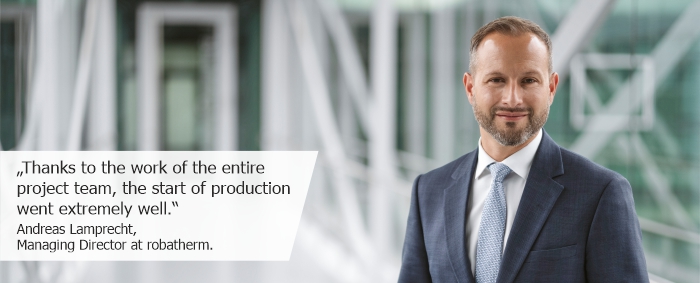What doesn't fit, is made to fit.
On a hunch? - Not a chance! During the changeover to TI-50, those responsible left nothing to coincidence. The official start of the new TI-50 casing production in January 2021 was a major milestone. The fact that this launch ran so smoothly is no coincidence. The preparations were both intensive and exhausting, yet, as the results show, they were well worth it.
robatherm's production and development engineers speak of “simultaneous engineering” when referring to the TI-50's development. The bottom line is that individual development stages that traditionally took place sequentially now chronologically overlap using this method. During the TI-50 development, the procedure would probably have been to develop a casing concept what it should look like in the future. Then, production would have begun to integrate this new package concept into their production processes. In some cases, that would have necessitated fundamental changes to the casing at a later stage in the development process; an incredibly time-consuming process. The robatherm project team has proven that this can also be done differently using simultaneous engineering.

Feasible? Feasible!
The most essential prerequisite is early communication and coordination between development and production. After all, in addition to product quality, the aim was to further enhance production processes and increase manufacturing efficiency. In the early stages of the project, prototypes and feasibility studies were created. This made it possible to check whether ideas could be realized and practically function at an early stage.
11,800 thermal panels by the time of commencement.
As early as May 2019, the increasingly complex TI-50 AHUs were produced as a pilot series. Each assembly and every AHU made was closely monitored and audited by a team from development and production. The findings from this pre-series flowed straight back into development and process engineering. By the start of series production in January 2021, 11,800 thermal panels and 2,200 doors of the new TI-50 casing, among other things, had been produced.
Concerned parties become team members
During each phase, feedback was gathered from various teams from the manufacturing and assembly departments. The insights gained were then directly incorporated into the development process. This improved the new development's quality. It also increased the employees' identification with the new casing while raising their acceptance of changes in future workflows. During the test phase, our production employees successfully attended theoretical and practical training courses. Despite regular production operations, the training courses were organized on a rotational basis to make this possible.

Changes in hardware and software
The introduction of TI-50 made extensive adjustments necessary in the areas of software and IT infrastructure, production processes, machine pool, workplace design, and material supply. The changeover to TI-50 meant that nearly 100 purchased parts were newly added to the portfolio for the purchasing department alone. The change in production became apparent with a fully automatic sawing center. The center was purchased and integrated into the machine pool to better map the order-specific profile variants for thermal panel production.
The challenge: synchronized production of two types of casing
Parallel production of two casing series, both the existing casing series and TI-50, presented a particular production challenge. Before commencing series production, pilot lines had already been introduced, and their workplaces prepared for the changeover to TI-50. Whereas the test devices became ever more complex and their share of the production capacity also continued to increase, it became necessary to simultaneously ensure that the previous casing series production processes were not compromised.
A quiet Christmas vacation? By no means.
The final changeover to TI-50 took place during Christmas vacation, so that TI-50 could be launched in January 2021. During the supposed time off, a team prepared the assembly lines and their workplaces, among other things. In Jettingen-Scheppach and Burgau's production plants, around 1,000 storage locations were converted. Approximately 1,750 boxes, so-called small load carriers (SLC), were exchanged.

All the more time for a longer test phase
Thanks to simultaneous engineering, subsequent development steps were initiated as soon as sufficient information had been acquired during the preceding development step. Thus, the commencing the following stage did not have to wait until the first step was fully completed. This resulted in a considerable level of communication, coupled with a significantly faster development time. This saved valuable time that could be extensively used for practical tests. Thanks to these intensive tests, TI-50 was not only ready for the market at the time of the official launch but had already proven itself in practice.

